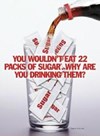September is National Cholesterol Education Month. Have you had your cholesterol checked lately? If not, it might be a good idea to do so to know if some lifestyle changes are in order. When it comes to cholesterol, it’s good to know your numbers. High blood cholesterol increases your risk for heart disease and heart attack, and lowering it decreases that risk. It’s that simple. So, September is a great time to learn about high blood cholesterol, especially if you are among the sixty-five (65) million Americans who have this condition. Did you know that with a combination of a heart healthy diet, physical activity, and weight management, you may be able to lower your high blood cholesterol by 20 to 30 percent?
Posted 9/22/2012 by Carolyn Wyatt, IFAS Extension in Hardee County

Posted 9/21/2012 by County of Los Angeles Public Health

Eating too much sugar is a major contributor to overweight and obesity. Sugar-loaded drinks, such as sodas, sports drinks, energy drinks, and even sweetened teas and fruit juices, are a large part of the problem.
Did you know?
- A 20-ounce soda can contain 65 grams of sugar? That’s approximately 22 packets of sugar in just one bottle. All that added sugar can have serious health consequences. The extra calories in sugar-loaded drinks can lead to obesity, diabetes and heart disease.
- A typical adult has to walk briskly for 46 minutes to burn the calories in a 20-ounce soda.
- A typical 10-year-old has to bike vigorously for 30 minutes to burn the calories in a 12-ounce soda.
It’s recommended to limit or eliminate sweetened beverages from your diet, replacing sugar-loaded drinks with water, unsweetened beverages and low-fat or non-fat milk.
Posted 9/19/2012 by www.extension.org

Snacking, especially beverage consumption outside of a regular meal, continues to increase among Americans, accounting for more than 25 percent of calorie intake each day. Between 1977 and 2006, snacking in the American diet has grown to constitute “a full eating event,” or a fourth meal, averaging about 580 calories each day, said Richard D. Mattes, Ph.D., professor of foods and nutrition at Purdue University.
Posted 9/16/2012 by www.fightbac.org

Over the years we have all heard advice related to food safety. Some of this advice rings true, while other guidance is just plain wrong.
Test your food safety knowledge by answering the following true or false food safety questions.
- Microwaving food kills bacteria so the food is safe to eat.
- You need to wash produce even if you are going to peel it.
- You need to wash all bagged lettuce and greens.
- You can re-freeze foods after you have thawed them – you don’t have to cook them or throw them away.
- Putting chicken in a colander and rinsing it with water will remove bacteria like salmonella.
- You should not put hot food in the refrigerator.
- Once a hamburger turns brown in the middle it is cooked.
Read the full article to find the answers.
Posted 9/15/2012 by Centers for Disease Control and Infection

Keeping hands clean is one of the best ways to prevent the spread of infection and illness.
Handwashing is easy to do and it's one of the most effective ways to prevent the spread of many types of infection and illness in all settings—from your home and workplace to child care facilities and hospitals. Clean hands can stop germs from spreading from one person to another and throughout an entire community.
Learn more about when and how to wash your hands.
Posted 9/9/2012 by www.letsmove.gov

Physical activity is an essential component of a healthy lifestyle. In combination with healthy eating, it can help prevent a range of chronic diseases, including heart disease, cancer, and stroke, which are the three leading causes of death. Physical activity helps control weight, builds lean muscle, reduces fat, promotes strong bone, muscle and joint development, and decreases the risk of obesity. Children need 60 minutes of play with moderate to vigorous activity every day to grow up to a healthy weight.
If this sounds like a lot, consider that eight to 18 year old adolescents spend an average of 7.5 hours a day using entertainment media including TV, computers, video games, cell phones and movies in a typical day, and only one-third of high school students get the recommended levels of physical activity.
Posted 9/9/2012 by www.presidentschallenge.org

This program truly lives up to its name. The Presidential Active Lifestyle Award challenge will help you add physical activity to your life—and now, it will also help improve your eating habits. (That’s why we’re calling it PALA+.) Get active and eat better, and you’ll feel better, too. Plus, you’ll earn an award.
This challenge is for anyone, from students to seniors, but it’s geared toward people who want to set themselves on the road to a healthier life through positive changes to physical activity and eating behaviors.
Posted 9/3/2012 by U.S. Department of Health & Human Services

September marks the start of National Childhood Obesity Awareness Month.
In the past four decades, obesity rates in the United States have soared among all age groups. This rise in obesity rates has affected our youth in alarming fashion. Childhood obesity has increased more than fourfold among those ages 6 to 11. More than 23 million children and teenagers in the United States ages 2 to 19 are obese or overweight, a statistic that health and medical experts consider an epidemic. And this epidemic puts nearly one third of America’s children at early risk for Type 2 diabetes, high blood pressure, heart disease and even stroke – conditions usually associated with adulthood. Even greater disparities exist among young Hispanics and children of color.
Posted 9/3/2012 by www.extension.org

Children spend more time sitting in front of electronic screens (screen time) than in any other activity besides sleeping. This means they spend more time in front of screens than they do in school. The average time spent with various media (television, computer, video games) is more than five hours per day. Even the very youngest children, preschoolers ages 6 and younger, spend as much time with screen media (TVs, video games, and computers) as they do playing outside. That means several hours of inactivity and, in the case of television viewing, hours of exposure to advertising for high-fat, high-calorie foods. Many of these ads are aimed directly at children. Too much screen time affects children’s brains and bodies.
Posted 9/2/2012 by www.extension.org

What is TV watching like in your house? In almost half of all homes in America, the TV is on most of the time. Families watch TV while eating dinner instead of talking to one another. Families spend time watching TV alone in their bedrooms. Family members may even watch the same show in different rooms. Even if you are watching in the same room, you are not talking and interacting.
To get your family away from the TV and bring your family closer, try these suggestions to have family time together:
| Previous Articles | More Articles |






